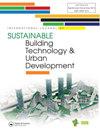利用建筑信息模型(BIM)对马来西亚一栋典型的低层办公楼进行碳足迹评估
Q4 Engineering
International Journal of Sustainable Building Technology and Urban Development
Pub Date : 2015-07-25
DOI:10.1080/2093761X.2015.1057876
引用次数: 44
摘要
混凝土和钢材被认为是当今建筑中的主要结构建筑材料。相当数量的碳足迹被称为隐含碳足迹在提取过程中释放到建筑活动的最终利用。然而,对不同等级的结构材料的隐含碳足迹的量化和评价是缺乏的。本研究旨在利用生命周期分析(LCA)评估在设计和规划阶段采用六种不同类别/等级的混凝土和钢材组合时隐含碳足迹潜力的变化。利用建筑信息模型(BIM)虚拟构建了一座两层的传统办公大楼,并量化了六个模型中每个模型的隐含碳足迹。该研究强调,高达31%的隐含碳足迹被避免来自建筑。型号M1 (G25XS280)的贡献最高,型号M4 (G35XS460)的贡献最低。…本文章由计算机程序翻译,如有差异,请以英文原文为准。
Carbon footprint assessment of a typical low rise office building in Malaysia using building information modelling (BIM)
Concrete and steel are considered the main structural building materials in today's construction. A fair amount of carbon footprint known as embodied carbon footprint is released during their extraction to ultimate utilisation in construction activities. However, quantification and evaluation of the embodied carbon footprint from structural materials of various grades was lacking. This study aimed to evaluate the variation in embodied carbon footprint potential when various classes/grades of concrete and steel in six different combinations were adopted during the design and planning phase using life-cycle analysis (LCA). Building information modelling (BIM) was utilised to virtually construct a two-storey conventional office building, and embodied carbon footprints for each of the six models were quantified. The study highlighted that up to 31% of embodied carbon footprint was avoided from the building. Model M1 (G25XS280) yielded the highest whereas model M4 (G35XS460) was the lowest in contribution. The...
求助全文
通过发布文献求助,成功后即可免费获取论文全文。
去求助
来源期刊

International Journal of Sustainable Building Technology and Urban Development
Engineering-Building and Construction
CiteScore
1.20
自引率
0.00%
发文量
0
期刊介绍:
The International Journal of Sustainable Building Technology and Urban Development is the official publication of the Sustainable Building Research Center and serves as a resource to professionals and academics within the architecture and sustainability community. The International Journal of Sustainable Building Technology and Urban Development aims to support its academic community by disseminating studies on sustainable building technology, focusing on issues related to sustainable approaches in the construction industry to reduce waste and mass consumption, integration of advanced architectural technologies and environmentalism, sustainable building maintenance, life cycle cost (LCC), social issues, education and public policies relating to urban development and architecture .
 求助内容:
求助内容: 应助结果提醒方式:
应助结果提醒方式:


